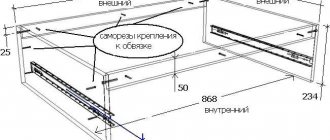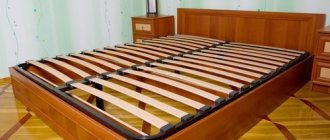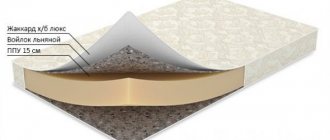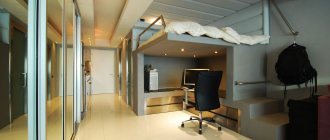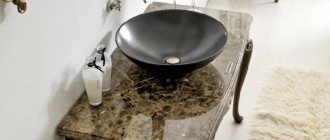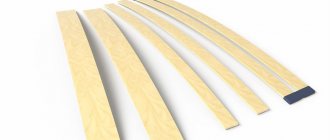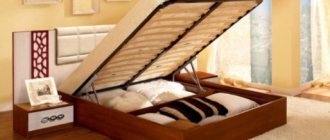A well-organized sleeping place ensures healthy, full sleep and good health while awake. It is not enough to simply buy a mattress with an orthopedic effect; you must choose the right base for it. An orthopedic bed base is a sleeping accessory that ensures the anatomically correct position of the sleeping person’s body.
Types of slatted bases
The ideal slatted bottom for your mattress
Did you know that 20% of the comfort of a sleeping place depends on the slatted bottom? If you are changing a mattress or want to make your existing one even more comfortable, pay attention to the slatted bottom. It affects the properties of the mattress and can significantly improve the quality of the entire sleeping area.
Our slatted bases use flexible slats made of bent-glued veneer. Each rail has a slightly curved shape and springs slightly when loaded. A mattress lying on such a bottom very effectively absorbs a person’s movements when he tosses and turns in his sleep.
The general rule is this: the more slats in the bottom, the more sensitive it is to the characteristics of the figure, which means the more comfortable the bed.
Based on the type of structure, a distinction is made between a slatted bottom on a frame (for example, LONSET) and a slatted bottom without a frame (for example, LUROY). Frameless slatted bases provide basic support and are less expensive.
In the slatted bottom on the frame, the slats are securely fixed using special fasteners, which eliminates the possibility of their displacement, while flexibility and effective shock absorption of movements are preserved.
The slatted bottom on the frame also allows you to make a slightly higher sleeping area with a thin mattress.
Different slatted bases may have different numbers of slats, and some also have so-called comfort zones.
In general, the dependence is as follows: the smaller the width of each slats and the closer to each other they are located, the more comfortable it is to sleep on such a bed.
Like a mattress, the slatted bottom can be divided into several comfort zones. In some models (for example, LEIRSUND), the stiffness of some slats, usually located in the shoulder area, can be adjusted using special sliders. In this way, you combine the comfort zones of the slatted bottom and the mattress, providing yourself with optimal support in the shoulders and hips and creating conditions in which your spine will maintain its anatomically correct shape.
There are adjustable slatted bases (for example, LAXEVOG slatted bottom). They allow you to change your body position in bed.
With a raised headboard, you will be comfortable reading or watching TV. In addition, during a cold, the reclining position makes breathing easier. And the raised foot will help relieve leg fatigue, especially if you walked a lot during the day or stood for a long time.
It is recommended to use such slatted bases with a polyurethane foam or latex mattress, as it will allow you to fully experience all the benefits of an adjustable bottom.
With the development of technology, new elements and designs appear that are designed to improve the quality of life of a modern person, including in the field of rest and sleep. Structural elements such as bed slats have become firmly established in our everyday life. Today it is almost impossible to imagine the furniture market without them. This article will tell you what lamellas are, why they are needed, and their pros and cons.
What are bed slats
What are they needed for
In the overall design, the slats have many useful functions:
- create natural ventilation for the mattress due to the presence of gaps between them;
- needed to reduce the load on the bed frame. Evenly distribute the weight of the mattress under itself, thereby extending the life of the bed;
- thanks to the curved shape, they create a light springing effect and increase the anatomical effect of the mattress, complementing its orthopedic properties;
There are also special orthopedic lamellas that allow you to adjust the rigidity of the base at its various points, selecting the optimal rigidity characteristics for the physiological characteristics of the sleeper. However, their high price does not yet allow this invention to become a mass product.
Photo: Orthopedic base for a slatted bed
Why is it worth purchasing our products?
In our online catalog you can find several types of bed frames, of absolutely any size.
Our experienced consultants can select the ideal option according to the client’s individual parameters and wishes. Elimet company offers:
- Only high-quality products from the manufacturer.
- Availability of all necessary documents and certificates of quality of materials and products.
- The most optimal prices for bed bases in Russia.
- Wide range of frames and various components.
- Absolutely safe for health ecological products.
Our company will provide you with wholesale supplies of the highest quality furniture. Contact our online consultant to clarify delivery details and find out the current price.
What are lamellas made of?
These structural elements can be made of wood as well as metal.
Wooden
Wooden bed slats are made from birch, linden, ash, maple, and beech. The most common and inexpensive are birch. They are light in weight and handle loads well. The most durable are beech.
Metal
They are much less common than the previous version. They differ in that they do not change their hardness throughout the entire service life. They do not bend under the mattress, but they have significant weight and can also make squeaks.
Sizes of bed slats
There are two types of lamellas in width: narrow and wide.
- Narrow ones (30-40 mm) must be placed in two rows, with each sleeping place having a separate base. This type of lamella arrangement is suitable for mattresses with independent springs.
- Wide slats (50-70 mm) are arranged in one row, unlike narrow ones, and are most often used in single or single beds. Wide slats are suitable for use with springless mattresses, as well as with Bonnell spring models.
The most acceptable thickness of the slats is 8-10 mm. The length of the slats may vary depending on the width of the bed.
Which lamellas are better – narrow or wide?
All lamellas can be divided into:
- Wide planks (from 50 to 70 mm). They are optimal for mattresses equipped with spring blocks or latex springless products. They are mounted at a distance of 4 to 6 cm from each other. Wide lamellas are convenient to use on tape, since if the length of the frame changes, they can be moved closer or further away.
- Narrow crossbars (from 30 to 40 mm). They are used for mattresses that have independent springs with high density. A grid of frequent narrow slats is used for folding beds, cribs and transformable beds.
By moving or moving the cursors along the bar, you can decrease or increase the stiffness in a specific area.
Important! The distance between narrow slats should not exceed their width.
A bed with or without slats: which is better?
The choice of slats material depends on the preferences, as well as the financial situation of the buyer.
For comparison, let's look at the advantages and disadvantages of each of the bases.
Solid bed bottom
- Ease of manufacture and versatility.
- Suitable for people with spinal problems who need a flat and hard surface.
- poor ventilation;
- does not have springing properties;
- provides worse orthopedic properties of the mattress.
Lamellar base
- Excellent ventilation.
- The orthopedic properties of the mattress increase.
- The slatted bottom type is more suitable for those who do not have too much weight.
- If the slats break, they can always be replaced, but if the bottom of the bed breaks, it can only be taken to a landfill.
- One lamella can withstand a load of 12 kg and in case of breakdown you will not have to change all the lamella fastenings.
- The bed is easier to move and transport.
- Plastic lat holders do not creak.
- Flexibility and resilience.
- Affordable price.
- Quick replacement.
- Easy to disassemble and assemble.
- Suitable for beds with a lifting mechanism.
- Has springy properties.
- may break;
- the cheapest models may squeak;
- Sometimes the slats pop out of the plastic tips.
To summarize, we can conclude that the base with slats wins on many counts. In the vast majority of cases, this is what is best for the bed.
The slats on the bed are creaking: what to do?
To assess the scale of the problem, you need to take a closer look not only at the slatted base, but also at the mattress, support slats, and also at the lifting mechanism, if any.
Why do the slats creak?
The base of a bed with slats creaks most often for two reasons:
- The fasteners were not tightened properly.
- Wooden elements rub against each other.
If the creaking of the lamellas began a year or two after purchase, then the wood may also be drying out. This process is completely natural and is influenced by the material of the boards from which the slats are made, as well as the microclimate of the room.
Material with low hygroscopicity practically does not creak. Indoor humidity of less than 50% slows down the drying process of the boards and, thereby, extends their service life.
What to do if the slats on the bed squeak
If you determine that it is the slats that are creaking, then you need to click on each one and determine which of the slats the sound comes from. They should also be checked for chips, cracks and other integrity problems. If damage is detected, the lamellas must be replaced. This will help remove the squeak and correct the situation.
Important! The slats should not wobble or dangle, all screws and screws should be in their places.
Manufacturing process
After purchasing the required materials and preparing the tools, you should begin marking and further cutting them. It is recommended to adhere to the following rules in this process.
The ideal method for attaching slats is with metal fasteners.
Ortho frame for baby crib
After making the marks, you can begin building the frame.
It is recommended to begin assembly by measuring the parameters of the mattress that will be used on this bed. It fits freely into the frame frame.
Slats are increasingly being used to provide an ideal and durable base for beds.
Using the taken parameters, saw off 2 end and long boards, which will become the sidewalls.
Reinforced block of slats for a high-quality bed base with a high degree of load.
Gather the resulting pieces into a rectangle. To fasten them together, you can use wooden spikes or eyes. Cut holes with a jigsaw. Can be hollowed out with a chisel.
Orthopedic base with adjustable positions
The resulting eyes are lubricated with glue and connected. Align everything at a 90 degree angle and, using clamps, secure until completely dry.
Choose the type of lamella fastening that will be the most durable and reliable.
The frame is ready. It is quite reliable and strong. To make assembling the base of a wooden bed an easy process, you should connect the parts using self-tapping screws that have additional fastenings and metal corners.
The slats fall out of the bed: what to do
This can happen either when the frame is assembled incorrectly, or the cause may be a technological defect. Perhaps the slats and lath holders are not designed for this bed. It is important to check and tighten the bolts of the sidewalls and corners.
Today, more and more often, solid bottoms are being replaced by beds that have slats in their design. After all, the slats themselves serve as an orthopedic bed, due to the fact that they enhance the effect of the mattress. Only with the correct position of the sleeper can sleep be full and healthy, so you need to choose slats in accordance with your state of health, weight, financial situation, and you should also consult with a good specialist.
Beds with springs have long since sunk into oblivion and have been replaced by modern models with orthopedic bases. Their design is like two peas in a pod and consists of a wooden box, a metal frame and one or two rows of lamellas - curved panels. The latter are responsible for the orthopedic properties of the sleeping place and take on the weight of the mattress and the person resting on it. What are slats for beds and what are their advantages over springs? Let’s look into this article.
Collapsible bed bases
Collapsible structures have been widely used for a long time.
Today, modern beds with a solid orthopedic base are gradually fading into the background - collapsible, high-quality collapsible bases have a safe, environmentally friendly coating.
The collapsible frame consists of an iron frame, lath holders, gas lifts, and birch slats.
They are the key to a comfortable sleep. Also, collapsible mechanisms allow you to create additional space for storing various things inside them.
What it is?
Slats are wooden plates, panels that make up the base of any modern bed. Their feature is a curved C-shape and the ability to withstand the large weight of a mattress + a person. Reiki can be made from:
- Birch is a plastic and affordable material;
- Linden trees are an inexpensive alternative;
- Beech;
- Ash;
- Maple.
Birch slats, or battens, are the most popular and affordable orthopedic slats. Beech and ash components are more expensive and are usually installed in 100% solid wood beds.
Why are they needed?
The orthopedic base of the bed is assembled like a puzzle - from a couple of dozen slats and a common metal frame that holds them together. Wooden strips create a slatted bottom on which an orthopedic mattress is placed. Modern mattress models do not tolerate uneven and questionable surfaces and are quite heavy in weight, and the slats, in turn, provide:
- Natural ventilation for the mattress due to the small distance between each of them;
- Reducing the load on the mattress and bed frame;
- They increase the anatomical effect of the mattress, that is, they complement its orthopedic properties;
- They create a light springy effect due to their curved shape, so this base does not creak or make other irritating sounds;
- They extend the life of the bed because they completely take on the weight of the mattress.
It is not for nothing that the slatted base of the bed is called orthopedic: it evenly distributes the load on the vacationer’s spine, providing him with high-quality and complete sleep.
The slats allow the mattress to “breathe” and remove moisture from it. We wrap every new mattress in a waterproof mattress cover, which can create a real greenhouse effect inside it. The slatted bottom eliminates this problem, and the orthopedic “friend” continues to serve us faithfully for decades.
Types of orthopedic bases with lamellas
Based on the dimensions of the bed, the orthopedic base for the mattress is divided into single and double models. Structurally, the base for a single bed consists of independent bent slats secured to the frame using lath holders. The double slatted bed base is equipped with an additional transverse rail that eliminates deflection and two rows of latoflexes.
The design of the mattress stand can be equipped with support legs and transformation mechanisms. Single stands have four legs, double models have additional central legs.
Some models of mattress stands have the function of adjusting the hardness of individual zones. To regulate the degree of rigidity, the bases are equipped with special clamps that allow the slats to be connected.
The standard length of a mattress stand, which has gained the most popularity, is 2000 mm. The furniture market also offers less popular non-standard sizes - 2050, 2100 and 2200 mm. For children's and teenage beds, bars with a length of 1700 to 1900 mm are provided.
Standard grille width:
- for a single bed – 700 mm;
- for double models – 1200,1400,1600,1800,2000 mm.
In what form can I buy it?
The slats are sold as part of an orthopedic base in a bed and separately - individually. Like any other element of the stock, they are subject to stress and can break. Experts do not recommend sleeping on a bed even without one lamella: firstly, the load on the other parts of the bed increases and their integrity is called into question, and secondly, the orthopedic properties of the mattress and base, which are designed to evenly distribute the load on the spine and ensure healthy sleep, are reduced.
The slats are sold individually or as a set according to the size of the bed or sofa, so if one plank is cracked or completely broken, replacing it will not be difficult; all that remains is to choose the right replacement in terms of thickness and width. A set of slats can be sold on a strip if your bed uses this slatting system (by the way, it is already outdated). Additionally, you will have to buy spare parts for attaching the rail: a cap-holder (internal or overhead). There are component caps that hold the slats and are attached to the metal base of the bed without “intermediaries.”
Which ones are better?
There are two types of slats: wide and narrow:
- Wide slats, about 900-1000 mm long, are installed in one row on the lattice and are often used in single or one-and-a-half beds. Slats across the entire width of the bed are suitable for springless mattresses and models with Bonnell springs.
- Narrow ones (700-800 mm) are arranged in two rows - each for one sleeping place. This type of lamella arrangement is recommended for mattresses with independent springs.
If we talk about the number of elastic panels, then the best option is 26-30 pieces for a double bed. For a single bedroom, the number of slats is half as much - 13-15 pieces. The greater the number of slats, the better: this number of slats ensures optimal flexibility of the bed base and can withstand more weight.
The lamellas differ in thickness, length, width and the distance that is formed between them. The optimal thickness of the slats is 8-10 mm, width is 5-7 cm, the length can vary depending on the width of the bed (140 cm, 160 cm, 180 cm - each of them will require slats of different lengths). There should be a distance between the slats no more than the width of one of them - about 4-7 cm.
There is another important classification - according to the type of lamella holders. Modern manufacturers attach latoflexes to special holders made of:
The slats on a strip or attached to a metal frame also move to the side, making room for a practical and lightweight fastening, which, in the event of a break, allows you to replace the latter yourself.
It is impossible to say which slats are better. If we talk about their fastening, it is better to choose rubber or polypropylene holders - they are stronger and better than their plastic counterparts.
What is a lamella
Otherwise, the slats are called battens or slats and look like a set of slightly curved planks. This design forms an elastic lattice with a springing effect, on which an orthopedic mattress is placed. Parts can have various fastenings, although most often rigid fastening elements or slats on tape are used.
The design of the bed with plates is divided into individual slats, they are very durable and each can withstand a weight of up to 40 kg.
Note! The orthopedic bed base, which has a rigid structure, significantly extends the life of the mattress.
The thickness of the plates varies from 1 to 10 mm, width - from 25 to 120 mm. During installation, their distance can reach from 2 to 6 cm. The designs of double beds provide two rows of slats designed for each of the sleepers.
The use of frequent installation ensures maximum reliability of the structure, so that the bed can be used even by people with significant weight. The greatest distance left between the slats is selected in case of light loads on the mattress. The standard design for a double bed frame with dimensions of 160x200 cm is a design with 30 crossbars. With fewer quantities, the required strength is often not achieved. The minimum number is 22 slats in the case of a double base.
Very often slats are used for orthopedic beds.
When choosing a bed or a base for it, you need to explore the possibility of purchasing accessories in case of damage or breakage of any elements. The fittings consist not only of lamellas, but also of lath holders, transformation mechanisms and gas lifts. If the orthopedic base is used incorrectly, it may become damaged, and then the lamellas can be replaced with your own hands.
To ensure that the plates bring health benefits and not harm, you should choose the right mattress.
Note! Often, breakage of lamellas occurs in the case of dry air indoors, which leads to drying out of the wood. To avoid this, you can regularly treat the surface of the slats with a damp cloth.
Dimensions
Beds vary in sleeping size, and each will require different lengths of slats. For a double bed 180x200 cm, slats with a width of 880885 mm are suitable, for a single bed - 900-990 mm, provided that the slats are lined up in one row, and 500 mm - for a pair of rows of slats. The slats can differ in size and even in bending angle, so before replacing and purchasing a separate slats, it is important to measure the length and width of the already installed parts in order to choose exactly the same one.
The lamellas differ in width - 40, 50, 70, 80 mm, but their thickness remains practically unchanged, the ideal is 8 mm.
How to choose?
When buying a bed with an orthopedic base or slatted bottom, pay attention to the number of slats.
The more there are, the better, experts say. And the wider the bed, the greater the number of slats should be at its base.
The optimal number of slats on a bed frame is 20-22 pieces for a bed 190-200 cm long. If there are more slats, then such a bed will be softer, more flexible and more functional, and will withstand more weight of the mattress. The slats differ not only in quantity, but also in the material from which they are made.
The most affordable is birch, which is not inferior in strength to harder wood species.
Birch slats are usually installed in economy and mid-segment beds. At the base of solid wood beds there are beech slats - strong and solid slats. Give preference to rubber or semi-propylene rack holders; plastic ones wear out quickly and are not so practical to use.
Pros and cons of slats
The following advantages of lamellas can be highlighted:
- enhancing the orthopedic and anatomical effect of the mattress due to the elastic base;
- ensuring natural air exchange thanks to the gaps between the slats;
- increasing the service life of the mattress due to the lamellas taking up a significant part of the load;
- possibility of easy replacement of strips;
- long period of use of furniture;
- noiseless design, ensured by special holders used to fix the plates;
- low cost of slats, which has little effect on the final price of the bed;
- ease of cleaning achieved due to the high base.
There are also a number of disadvantages:
- the possibility of conflict with mattresses that are equipped with thin covering protection and springs of small diameter, since in this case the springs can be pressed into the gaps between the slats;
- small selection of models;
- lack of protection of the mattress from below from the smell of things from the pencil case, moisture and dust accumulating under the furniture.
The buyer can independently choose the material from which the lamellas will be made.
How to do it yourself?
Natural wood is used to produce lamellas - birch or poplar are suitable. Making an orthopedic bed base and slats with your own hands has a great advantage - you can choose the number of slats yourself. To do this you will need:
- Mounting slats or birch plywood 1.5-2 mm thick;
- Fastenings for lamellas - rubber or foam propylene;
- Cutting tool.
The process of creating lamellas begins with a drawing and cutting out planks of the same size according to it
To make the job as simple as possible, choose smooth 100% birch plywood without knots or roughness so that you don’t have to further process it.
What does the frame consist of and what types can it be?
The base of the bed consists of two parts - a metal structure and slats. The frame is made of all-welded metal or profile pipe.
The difference between them is only in size and weight, but both materials are very reliable and durable. The slats are made of beech plywood, with a thickness of 50 mm or more.
They are flexible and plastic, which is why they do not break under heavy weight and impacts. They also support the entire body, relieving compression from the spine.
How to insert?
The slats are attached to the metal frame of the bed in the following way: a special cap is put on it and in this form they fit into the hole (socket) at the base of the bed.
To remove the lamella or exchange a damaged part for a whole one, bend the bar and remove the fastener from the socket. Remove the middle caps on both sides and replace the latter with a new complete strip. Put the caps back on, insert one end of the lamella into the socket, bend it and place the other end into the hole on the other side of the frame.
To attach the part to the frame correctly, you will need to apply a little effort and bend the bar: it will not break.
To learn how to properly install slats on a bed, watch the following video.
Final stage
Now you can proceed to assembling the slatted base. These are cross bars that support the mattress and prevent it from deforming.
Slats at the base of the sofa
- Tap the fastening locking strip along the base, side and end parts.
- Mark at a height of at least 100 mm of the edge from above.
- The rail is attached around the entire perimeter using a solid line and a dotted line. You can use a metal corner instead.
- You will need a block with a section of 30x30. Use it to make a frame for the crossbar. They fasten it according to the internal parameters of the base.
- Then a rail measuring 150x4x2 cm is placed on the frame. Fasten it across the length. The distance is at least 5 cm.
The lamellas must be attached to the metal frame using metal fasteners.
If you carry out all the steps strictly following the drawings, you will not have any problems with installation. At the final stage, the base should be treated with sandpaper and coated with varnish.
The chalk holder can be completely invisible, but at the same time as durable as possible.
You should carefully consider the choice of covering for the finished bed. After all, it must completely fit into the interior of the room. Before coating the product with varnish, it is recommended to first tone it. Stain is suitable for this.
Reinforced metal fastening for wooden slats
It should be applied evenly using a brush. The surface should be varnished only after the stain has dried. It is necessary to make 2 layers of varnish.
